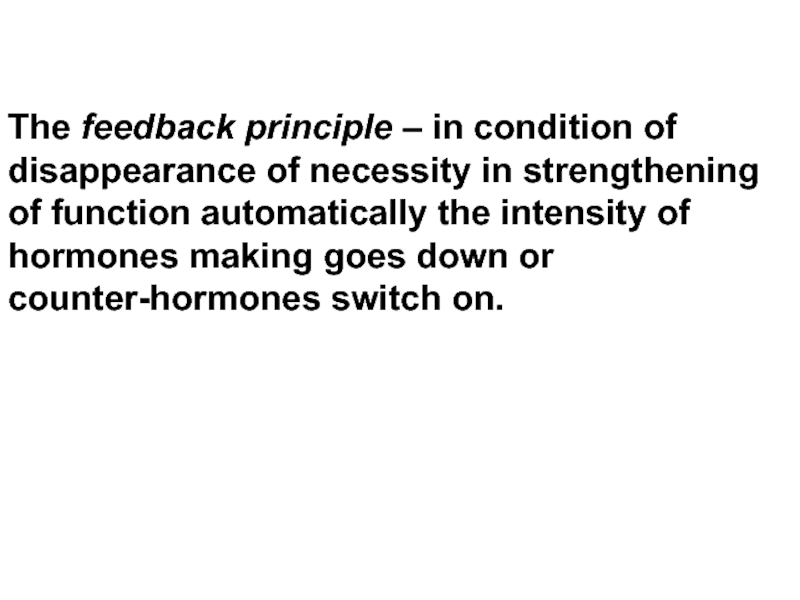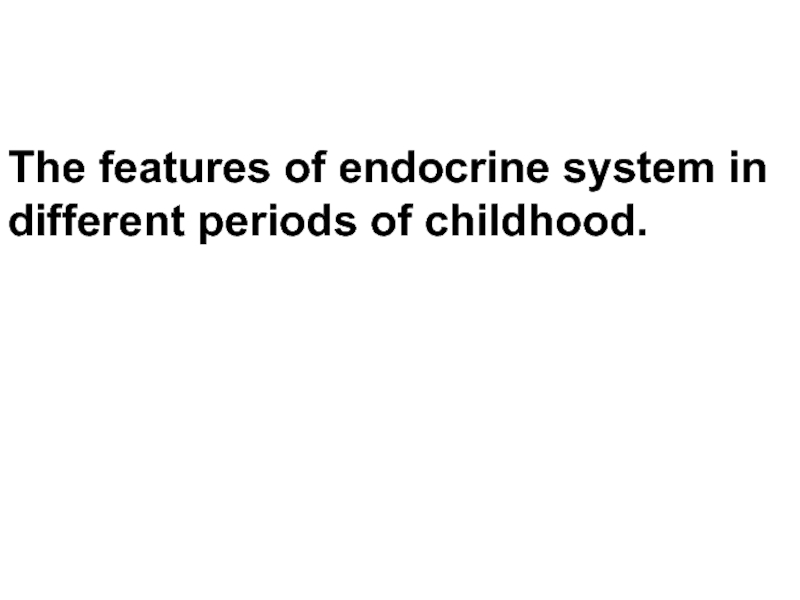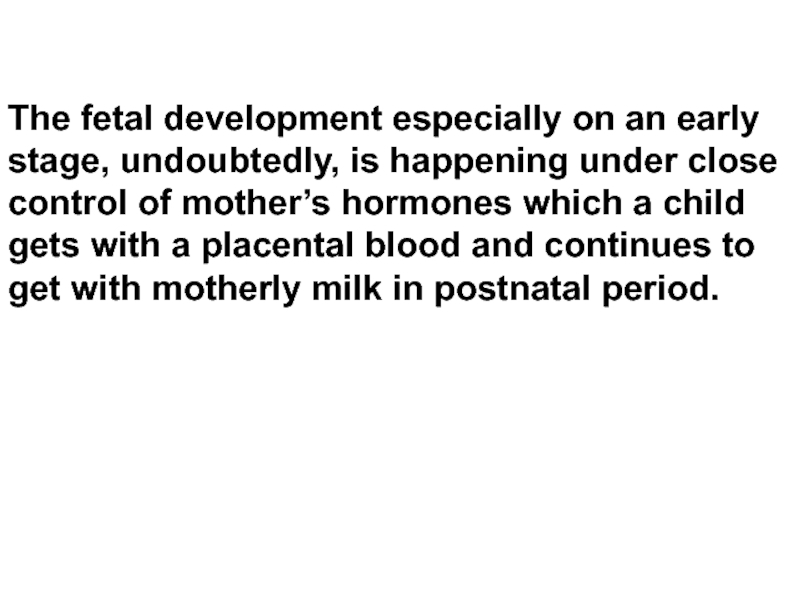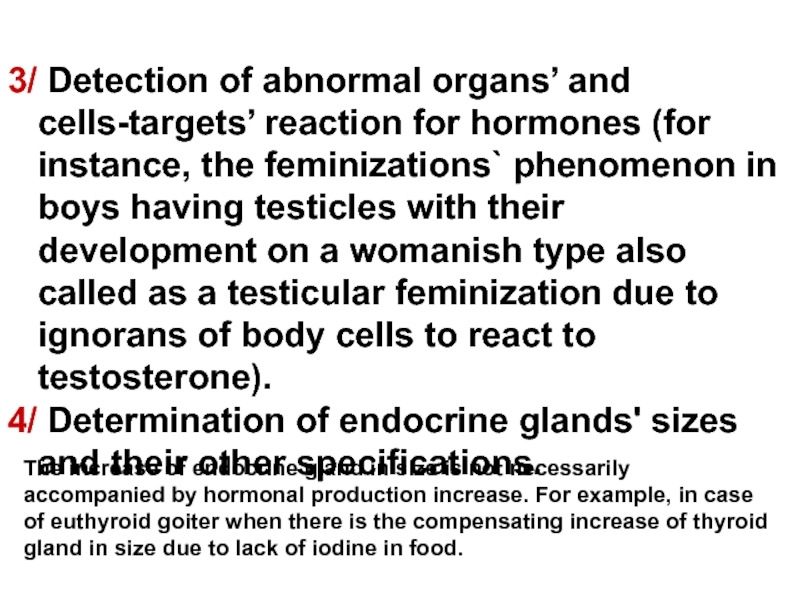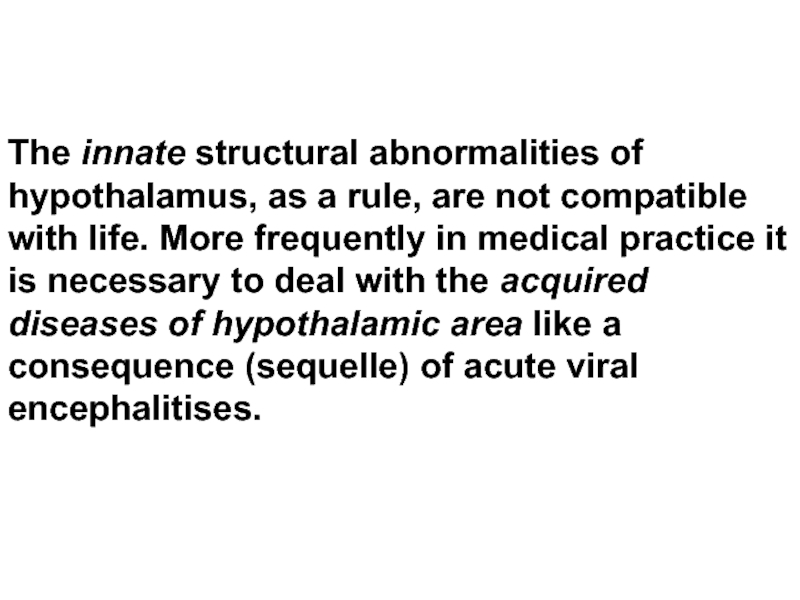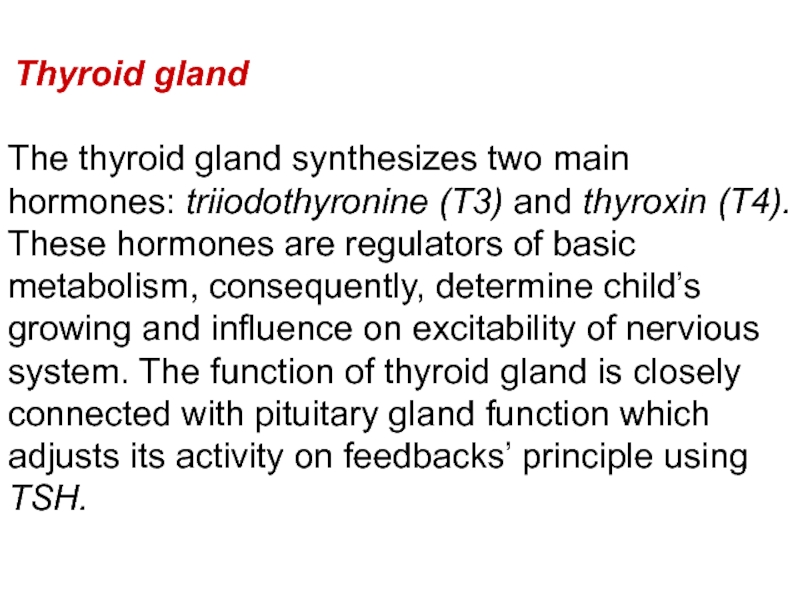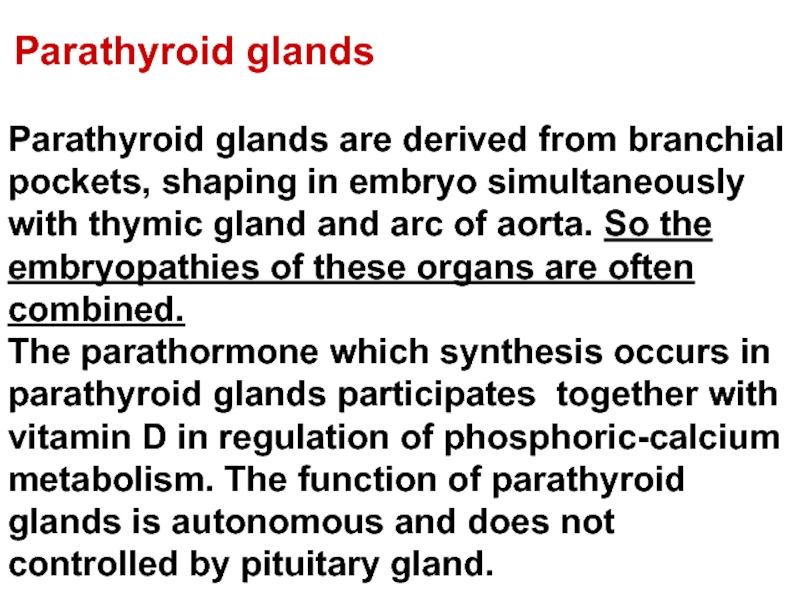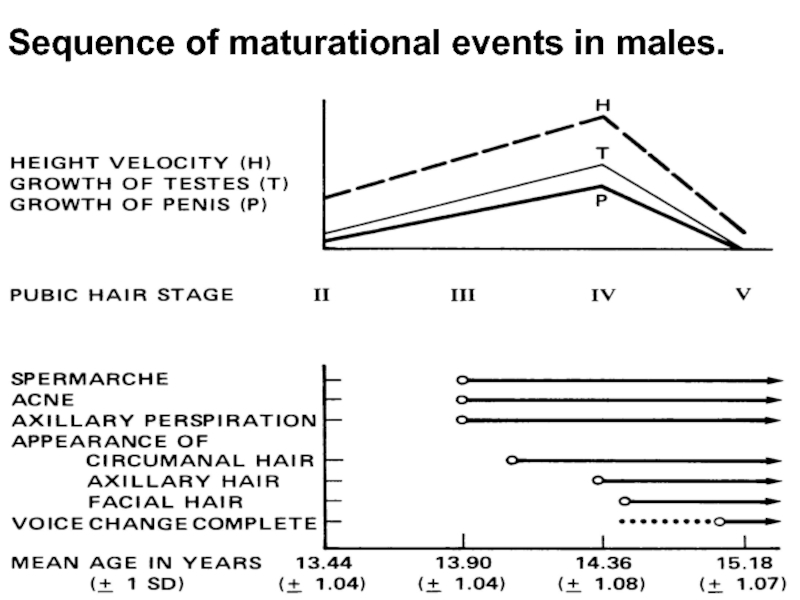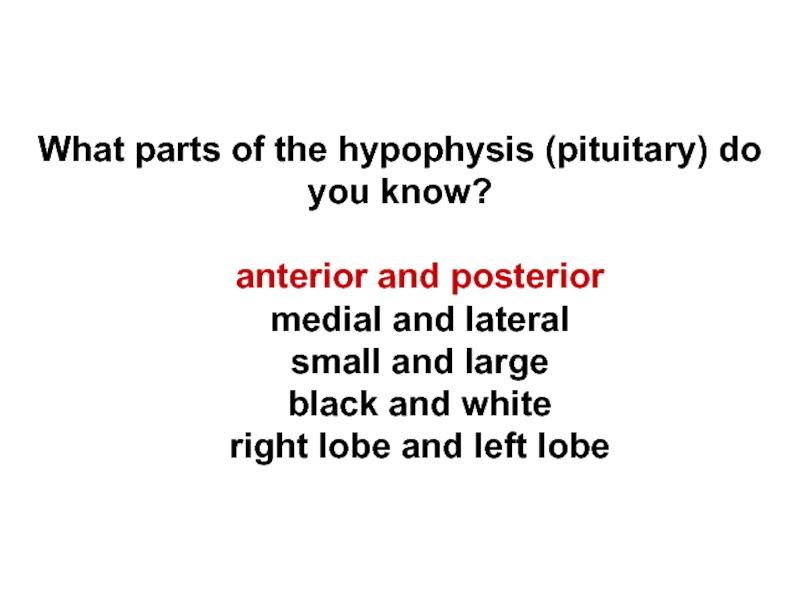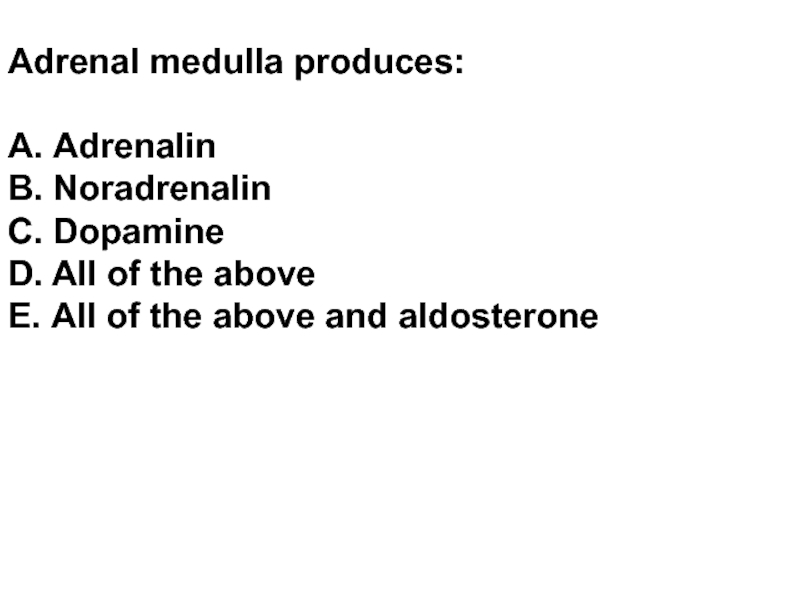- Главная
- Разное
- Дизайн
- Бизнес и предпринимательство
- Аналитика
- Образование
- Развлечения
- Красота и здоровье
- Финансы
- Государство
- Путешествия
- Спорт
- Недвижимость
- Армия
- Графика
- Культурология
- Еда и кулинария
- Лингвистика
- Английский язык
- Астрономия
- Алгебра
- Биология
- География
- Детские презентации
- Информатика
- История
- Литература
- Маркетинг
- Математика
- Медицина
- Менеджмент
- Музыка
- МХК
- Немецкий язык
- ОБЖ
- Обществознание
- Окружающий мир
- Педагогика
- Русский язык
- Технология
- Физика
- Философия
- Химия
- Шаблоны, картинки для презентаций
- Экология
- Экономика
- Юриспруденция
Endocrine system in children презентация
Содержание
- 1. Endocrine system in children
- 2. Endocrine system of regulation means
- 3. Hormones are peculiar envoys, commands, coded by
- 4. There is general conformity to
- 5. Organization of hormonal management in
- 6. The feedback principle – in condition
- 7. Endocrine glands possessing an intra-secretory function include
- 8. Each of the endocrinal glands
- 9. The main organizing center which provides
- 10. Efficiency of hypothalamus` work is explained that
- 11. The system of the endocrine
- 12. The features of endocrine system in different periods of childhood.
- 13. Most endocrine glands' organogenesis and the
- 14. From positions of embryology it is necessary
- 15. The fetal development especially on an early
- 16. Benign gynecomastia in a newborn due to hyperestrogenemia in a mother.
- 17. The endocrine diseases of mother with high
- 18. In prenatal period the hypophysis and thymus
- 19. The essence of endocrine regulation in human
- 20. Principles on which the clinical research
- 21. 3/ Detection of abnormal organs’ and cells-targets’
- 22. Description of ductless glands in children,
- 23. Hypothalamus. Hypothalamus is the part of
- 24. The innate structural abnormalities of hypothalamus,
- 25. Semiotics of hypothalamic lesions. The
- 26. Hypophysis (pituitary cerebri). The pituitary gland
- 27. The anterior hypophysial lobe (anterior pituitary) produces
- 28. What is the physiological role of STH
- 29. The posterior hypophysial lobe (posterior pituitary) is
- 30. Semiotics of pituitary gland’s
- 31. The anterior hypophysial lobe’s hyperfunction
- 32. Cerebral gigantism in an 8-yr-old boy. The
- 33. If the hormonal active adenoma of anterior
- 34. The hypofunction of anterior lobe of pituitary
- 35. The common functional disturbances of anterior hypophysis
- 36. Hypophysail posterior lobe’s dysfunction. Due to insufficient
- 37. Objective visiul stady of the
- 38. Roentgenograph of the skull of
- 39. Adrenal glands Adrenal cortex produces
- 40. The production of cortico - and mineralocorticosteroids
- 41. The role of adrenal glands’ sexual hormones
- 42. At the beginning of pubertal stage (approximately
- 43. Semiotics of adrenal cortex’ lesion
- 44. The acute adrenal insufficiency syndrome The
- 45. The abnormally increased function of adrenal cortex
- 46. The genetically determined disturbances with hyperproduction of
- 47. In neonatal adreno-genital syndrome the sex determination can be difficult.
- 48. In elder age (between 3 and 8
- 49. Semiotics of selective lesion of suprarenal
- 50. Thyroid gland The thyroid gland
- 51. Thyroid gland functional insufficiency Thyroid
- 52. The clinical manifestations of congenital hypothyroidism
- 53. The late symptoms of innate
- 54. Congenital hypothyroidism in an infant 6 mo
- 55. Among additional confirmatory investigations the X-Ray symptome
- 56. Rickets in a 2-year-old child presenting with
- 57. The laboratory study confirms the
- 58. Hyperthiroidisms (exophthalmic goitre, Graves’ disease, thireotoxicosis and
- 59. Onycholysis associated with hyperthyroidism
- 60. The sizes and other characteristics of thyroid
- 61. Parathyroid glands Parathyroid glands are
- 62. Functional insufficiency of parathyroid glands (due to
- 63. Innate hyperparathyroidism is accompanied by
- 64. The hypertrophy (hyperplasia) of thymus if it
- 65. Epiphysis (pineal gland). In children
- 66. Pancreas Pancreas as an organ
- 67. Gonadial glands development and puberty. Boys’
- 68. Sequence of maturational events in males.
- 69. Sex maturity ratings of pubic hair
- 70. Puberty in girls. Period of puberty in
- 71. The girls aged approximately 14,5 - 15
- 72. What parts of the hypophysis (pituitary) do
- 73. What parts of the hypophysis (pituitary) do
- 74. What hormone does the thyroid gland secrete?
- 75. What hormone does the thyroid gland secrete?
- 76. Which hormone is secreted by the hypothalamus
- 77. Which hormone is secreted by the hypothalamus
- 78. Adrenal medulla produces: А. Adrenalin
- 79. Adrenal medulla produces: А. Adrenalin
- 80. In children with congenital hypothyroidism the serum
- 81. In children with congenital hypothyroidism the serum
- 82. A 1-day-old full-term neonate assessed as a
- 83. A 1-day-old full-term neonate assessed as a
- 84. Ocular manifestation of Graves disease (thyreotoxicosis) include
- 85. Ocular manifestation of Graves disease (thyreotoxicosis) include
- 86. A 3-mo-old infant has feeding problems, lethargy,
- 87. A 3-mo-old infant has feeding problems, lethargy,
- 88. Congenital hypoparathyroidism is associated with: hypocalcaemia
- 89. Congenital hypoparathyroidism is associated with: hypocalcaemia
- 90. All of the following may be manifestations
- 91. All of the following may be manifestations
Слайд 2
Endocrine system of regulation means endocrine glands’ cells production of the
Слайд 3Hormones are peculiar envoys, commands, coded by a chemical way. Depending
Слайд 4
There is general conformity to the law of the endocrine system
Слайд 5
Organization of hormonal management in an organism is based on doubling
Слайд 6
The feedback principle – in condition of disappearance of necessity in
Слайд 7Endocrine glands possessing an intra-secretory function include a hypophysis (pituitary gland,
Слайд 8
Each of the endocrinal glands possesses a specific function, but all
Слайд 9
The main organizing center which provides regulation in the conditions of
Слайд 10Efficiency of hypothalamus` work is explained that it is a part
Слайд 11
The system of the endocrine regulation depends very much on ability
Слайд 13
Most endocrine glands' organogenesis and the hypothalamus` formation begin on 5
Слайд 14From positions of embryology it is necessary to define the hypothalamus,
Слайд 15The fetal development especially on an early stage, undoubtedly, is happening
Слайд 17The endocrine diseases of mother with high concentrations of hormones in
Two male infants (twins) with neonatal congenital hyperthyroidis
Clinical features include lack of subcutaneous tissue and wide-eyed, anxious stare.
Слайд 18In prenatal period the hypophysis and thymus achieve the most anatomic
After birth the adrenal, pancreas, thyroid and parathyroid glans are advancing quickly while the hormonal activity of thymus is exposed to reverse fase.
Teens - the turbulent development of sexual glands begins at onset of pubertal period. The definitive forming of them signifies ending of childhood and their age involution means old age coming.
Summary:
Слайд 19The essence of endocrine regulation in human organism.
The hormonal system
For example, thyreotropin-dismissive hormone of hypothalamus promotes making of anterior hypophysial lobe’s the thyroid-stimulating hormone (TSH, thyrotrophin, thyrotropic hormone) which in its turn stimulates making of thyroid hormones–triiodothyronine and thyroxin. The sufficient contents of thyroxin brakes hypothalamus and its stimulating function fades.
Слайд 20 Principles on which the clinical research of endocrinal system is
1/ Detection of signs and syndromes which are characteristic of hyper- or hypoproduction of hormones in a patient.
2/ Determination of hormones’ concentrations in blood serum, taking into consideration the principle of feedback. It means if the countent of eventual effectoring (tissue) hormone is low the simultaneouse increasing of hypophysial and hypothalamic fuction happens with proper tropic and releasing hormones production. (And vice versa).
Слайд 213/ Detection of abnormal organs’ and cells-targets’ reaction for hormones (for
4/ Determination of endocrine glands' sizes and their other specifications.
The increase of endocrine gland in size is not necessarily accompanied by hormonal production increase. For example, in case of euthyroid goiter when there is the compensating increase of thyroid gland in size due to lack of iodine in food.
Слайд 22
Description of ductless glands in children, effects of their hormones on
Слайд 23Hypothalamus.
Hypothalamus is the part of cerebral trunk and simultaneously supreme organ
Слайд 24
The innate structural abnormalities of hypothalamus, as a rule, are not
Слайд 25 Semiotics of hypothalamic lesions.
The hypothalamic syndrome (hypothalamic disfunction) proves
Слайд 26Hypophysis (pituitary cerebri).
The pituitary gland is also derived part of brain
Слайд 27The anterior hypophysial lobe (anterior pituitary) produces several tropic peptide hormones.
Слайд 28What is the physiological role of STH in childhood period?
In
Слайд 29The posterior hypophysial lobe (posterior pituitary) is anatomically closely connected with
Слайд 31
The anterior hypophysial lobe’s hyperfunction (commonly due to adenoma) occures
Слайд 32Cerebral gigantism in an 8-yr-old boy. The height age was 12
Notice the prominence of the forehead and the jaw and the large hands and feet.
The adult height is 208 cm. He wears size 48 shoes.
Слайд 33If the hormonal active adenoma of anterior lobe of pituitary gland
Слайд 34The hypofunction of anterior lobe of pituitary gland usually proves itself
Слайд 35The common functional disturbances of anterior hypophysis can provoke disturbance touch
Слайд 36Hypophysail posterior lobe’s dysfunction. Due to insufficient production of ADH the
Слайд 37
Objective visiul stady of the pituitary gland is possible observing size
Слайд 38 Roentgenograph of the skull of a 9-yr-old boy with
The patient returned at 14 yr of age because of growth failure and delay in sexual maturation. Studies revealed a deficiency of growth hormone, gonadotropins, corticotropin, and thyrotropin. Note the enlargement of the sella turcica. There was exacerbation of diabetes insipidus with the administration of hydrocortisone and thyroxine. At surgery, a large craniopharyngioma was found.
Слайд 39Adrenal glands
Adrenal cortex produces more than 60 biologically active materials
Слайд 40The production of cortico - and mineralocorticosteroids are found under control
Слайд 41The role of adrenal glands’ sexual hormones is especially important in
In period of human life since the birth till adolescens the small amouts of adrenal sexual hormones regulate only anabolic reaction and support the growing. The bodies of children in their 8-9 years practically do not differ too much in boys and girls. The genitalias formed according to genotypical sign are an exception.
Слайд 42At the beginning of pubertal stage (approximately in 11 years old
Subsequently only the sexual glands’ activity for all time of sexual puberty will provide forming of secondary sexual signs.
After the age dependant involution of gonades the adrenals again will become a source of testosterone like in early childhood and this hormone will maintaine the anabolic reactions in olderness.
Слайд 43 Semiotics of adrenal cortex’ lesion
About adrenal cortex’ activity the clinicians
Слайд 44The acute adrenal insufficiency syndrome
The signs are weak and rapid
The chronic suprarenal insufficiency (Addison’s disease)
The signs are the weight losing, edvanced muscular weakness, peculiar brownish skin colouration on abdomen, on area of genitalia and joints (“bronze disease”). The serum hyponatremia and hyperkalemia are characteristic.Both for acute and for chronic forms of adrenal insufficiency it is characteristic of serum low levels of glucocorticoids and mineralocorticoids. Besides, for chronic form of insufficiency it is typical of high concentration of serum ACTH as result of futile pituitary`s signals to intensify the suprarenals` function.
Слайд 45The abnormally increased function of adrenal cortex with hypersecretion of glucocorticoids,
Слайд 46The genetically determined disturbances with hyperproduction of 17- ketosteroides (testosterones` line)
The affected children develops so-called adreno-genital syndrome. The clinical pattern of syndrome is the most tipical in girls. In them the external genitails’ virilization can occur in children even in utero. The external genitalias are getting masculine: the clitoris hypertrophies and labia becomes to look like a scrotum. The sex determination in newborn becomes difficult. Some forms of adreno-genital syndrome are accompanied with lack of mineralocorticoids and phenomenon of sodium loss with urine and severe vomiting. The affected children are getting dehydrated.
Слайд 48In elder age (between 3 and 8 years in girls and
A 6-yr-old girl with congenital adrenal hyperplasia. The urinary 17-ketosteroids were high (50 mg/24 hr).
B. Notice the clitoral enlargement and labial fusion.
Five-yr-old brother was not considered to be abnormal by the parents. The urinary 17-ketosteroids were also high (36 mg/24 hr).
Слайд 49 Semiotics of selective lesion of suprarenal medulla.
The main hormones
Слайд 50 Thyroid gland
The thyroid gland synthesizes two main hormones: triiodothyronine (T3)
Слайд 51Thyroid gland functional insufficiency
Thyroid gland functional insufficiency or hypothyroidism is
Слайд 52
The clinical manifestations of congenital hypothyroidism appear in neonatal period or
The cretinism means the dwarfism with mental retardation.
Early manifestation in neonatal period include:
feeding difficulties (lack of interest and choking spells;
respiratory difficulties (nasal obstruction or labored and noisy respiration;
prolonged physiological jaundice as an important sign for suspicion.
Слайд 53
The late symptoms of innate hypothyroidism, as a rule, are
The coarse features are: large head, coarse hair, low anterior hair line, wrinkled forehead, swollen eye lids and thick protruded tongue. Sometimes the hoarse voice attracts attention on. The umbilical hernia is present. Simultaneously the motor (the child does not head support, delayed sitting, standing) and mental (does not smile, laughing, recognize of mother etc.) delay is progressing.
Слайд 54Congenital hypothyroidism in an infant 6 mo of age. The infant
A.Notice the puffy face, dull expression, and hirsute forehead. Osseous development was that of a newborn.
B. Four mo after treatment, notice the decreased puffiness of the face, the decreased hirsutism of the forehead, and the alert appearance.
Слайд 55Among additional confirmatory investigations the X-Ray symptome of bone ossification delay
Congenital hypothyroidism:
Absence of distal femoral epiphysis in a 3-mo-old infant who was born at term. This is evidence for the onset of the hypothyroid state during fetal life.
Слайд 56Rickets in a 2-year-old child presenting with bowing of legs, abnormal
Слайд 57
The laboratory study confirms the diagnosis. The serum concentration of TSH
Слайд 58Hyperthiroidisms (exophthalmic goitre, Graves’ disease, thireotoxicosis and other names). The symptoms
Слайд 60The sizes and other characteristics of thyroid gland should be estimated
Слайд 61 Parathyroid glands
Parathyroid glands are derived from branchial pockets, shaping in
The parathormone which synthesis occurs in parathyroid glands participates together with vitamin D in regulation of phosphoric-calcium metabolism. The function of parathyroid glands is autonomous and does not controlled by pituitary gland.
Слайд 62Functional insufficiency of parathyroid glands (due to their aplasia, damages in
Слайд 63
Innate hyperparathyroidism is accompanied by hypercalcemia with nephrocalcinosis development and nephrolitiasis
Слайд 64The hypertrophy (hyperplasia) of thymus if it is revealed in young
Thymic "sail sign".
Слайд 65 Epiphysis (pineal gland).
In children the epiphysis (breins` derived gland) has
Слайд 66 Pancreas
Pancreas as an organ of endocrinal system works out insulin
Слайд 67 Gonadial glands development and puberty.
Boys’ puberty.
The main
Слайд 69
Sex maturity ratings of pubic hair development in adolescent boys. (By
Слайд 70Puberty in girls.
Period of puberty in girls is characterized by gradual
Слайд 71The girls aged approximately 14,5 - 15 years reach the definitive
Слайд 72What parts of the hypophysis (pituitary) do you know?
anterior and posterior
medial and lateral
small and large
black and white
right lobe and left lobe
Слайд 73What parts of the hypophysis (pituitary) do you know?
anterior and posterior
medial and lateral
small and large
black and white
right lobe and left lobe
Слайд 74What hormone does the thyroid gland secrete?
T4 - thyroxine
TSH
Aldosterone
vasopressin
insulin
Слайд 75What hormone does the thyroid gland secrete?
T4 - thyroxine
TSH
Aldosterone
vasopressin
insulin
Слайд 76Which hormone is secreted by the hypothalamus and stored in the
Somatotropic
thyrotropic
antidiuretic
adrenocorticotropic
follicle-stimulating
Слайд 77Which hormone is secreted by the hypothalamus and stored in the
Somatotropic
thyrotropic
antidiuretic
adrenocorticotropic
follicle-stimulating
Слайд 78Adrenal medulla produces:
А. Adrenalin
В. Noradrenalin
С. Dopamine
D. All
Е. All of the above and aldosterone
Слайд 79Adrenal medulla produces:
А. Adrenalin
В. Noradrenalin
С. Dopamine
D. All
Е. All of the above and aldosterone
Слайд 80In children with congenital hypothyroidism the serum blood tests reveal:
decreased ТSH
Increased
Increased Т3
increased Т4
decreased ТSH, Т3, Т4
Слайд 81In children with congenital hypothyroidism the serum blood tests reveal:
decreased ТSH
Increased
Increased Т3
increased Т4
decreased ТSH, Т3, Т4
Слайд 82A 1-day-old full-term neonate assessed as a female manifests ambiguous genitalia.
A. Chromosomal abnormalities
B. Suprarenal gland dysfunction
C. Brain tumor
D. Congenital viral infection
E. Nothing from all the above
Слайд 83A 1-day-old full-term neonate assessed as a female manifests ambiguous genitalia.
A. Chromosomal abnormalities
B. Suprarenal gland dysfunction
C. Brain tumor
D. Congenital viral infection
E. Nothing from all the above
Слайд 84Ocular manifestation of Graves disease (thyreotoxicosis) include is:
A. lid palsy
B.
C. squint
D. frequent blinking
E. conjunctivitis
Слайд 85Ocular manifestation of Graves disease (thyreotoxicosis) include is:
A. lid palsy
B.
C. squint
D. frequent blinking
E. conjunctivitis
Слайд 86A 3-mo-old infant has feeding problems, lethargy, and constipation. Physical findings
А. congenital hypothyroidism
В. hyperthyroidism
С. congenital hypopituitarism
D. hypoparathyroidism
Е. rickets
Слайд 87A 3-mo-old infant has feeding problems, lethargy, and constipation. Physical findings
А. congenital hypothyroidism
В. hyperthyroidism
С. congenital hypopituitarism
D. hypoparathyroidism
Е. rickets
Слайд 88Congenital hypoparathyroidism is associated with:
hypocalcaemia
hyponatremia
hypoglycemia
hyperbilirubinemia
hypokalemia
Слайд 89Congenital hypoparathyroidism is associated with:
hypocalcaemia
hyponatremia
hypoglycemia
hyperbilirubinemia
hypokalemia
Слайд 90All of the following may be manifestations of an insulin reaction
Loss of appetite
Sweating
Lethargy
Bizarre (strange) behavior
Slurred speech
Слайд 91All of the following may be manifestations of an insulin reaction
Loss of appetite
Sweating
Lethargy
Bizarre (strange) behavior
Slurred speech





